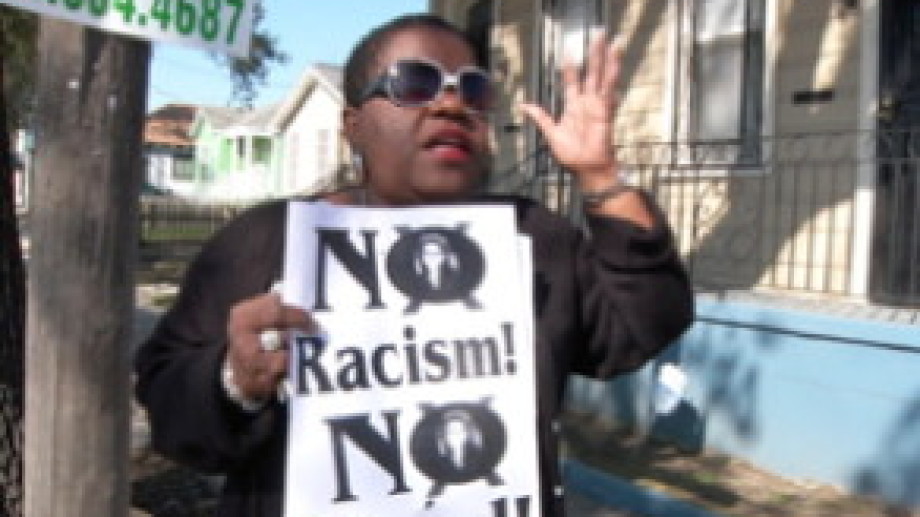
While some documentaries are about horrific tragedies, others focus on their aftermath. Screening this Thursday in our ongoing Art of the Real series, the “post-post” Hurricane Katrina doc Getting Back to Abnormal falls very much into the second category.
Filmed during election season 2010, the movie follows a battle for a spot in New Orleans' District B city council. In one corner is Stacy Head, a white woman accused of racism and general aloofness. In the other is Corey Watson, a young black preacher with a passion for energetic performance. If there's one thing this documentary makes clear, it's that politics matter in this city.
“The thing that’s unbelievably critical to living in Louisiana and New Orleans, in particular, is the politics,” co-director Louis Alvarez recently told FilmLinc Daily. “It’s a spectator’s sport. For example, in New York we just had this election and people didn’t even know who they were going to vote for in terms of their local council person until they walked into the booth. In New Orleans they would have been… for a year ahead of the election… they would have been fighting it out and arguing the merits of various people.”
Getting Back to Abnormal is about more than the in-and-out minutia of building a campaign, however. It sheds light on the people who are affected by the election's potential impact.
“We’ve been making documentaries where politics play an important role for many, many years, i.e. Louisiana Boys: Raised On Politics and Vote For Me: Politics in America,” Alvarez continued. “We’re not so concerned with the horse race and who wins and who loses, but generally how the game is played and who’s involved in it.”
Given its diversity, the history of New Orleans is grounded in, and occasionally divided by, the issue of race.
“When we started shooting there was still a black mayor, Ray Nagin,” Alvarez explained, “and the city council was either majority black or had just switched over to being majority white. To a certain degree, the changes in New Orleans have been a product of the post-Katrina demographics, where the poorest people didn’t come back after the storm—after they were displaced. So that was an enormous concentration, like the base for a lot of black politicians down in New Orleans. When you go to New Orleans, it’s extremely integrated in terms of City Hall and the the major offices, but you wouldn’t have expected to see so many white politicians in office given how things have changed the last few decades. What’s interesting and complicated about New Orleans is a little bit like what happened last week here in New York. You can’t use old fashioned identity politics to figure out who’s going to be on whose side.”

How did this team of four directors come across such a hot button political battleground?
“At the time we were sniffing around and looking for stories,” Alvarez recollected. “Stacy [Head]’s profile had become very high because she had made a number of statements. She had sort of put herself out there with relatively controversial remarks regarding race… Here’s a woman who’s very outspoken. Given the general racial dynamics of the city, wouldn’t it be interesting if we were able to spend some time with her, see what makes her tick and maybe follow her around a bit, and see what we can stir up? As it turns out, she became a major figure in the movie, as did her reelection and the crew of folks who she brought along with her, most prominently Barbara Lacen-Keller, her amazing liaison with the black community.”
The film presents a city trying desperately to rebuild while unsure of who to hire, or trust, to do the job. These residents, passionate people wishing to stop the the removal of public housing (keeping Brad Pitt's Make It Right foundation out) while demanding truth from their politicians and maintaining a positive outlook, give the film its shape.
“There were so many movies made about the storm and people who lived through the storm,” admitted co-director Andrew Kolker. “Some of them were good, some of them were not good. We thought, by and large with a couple of exceptions, the real story of New Orleans—the story of how New Orleans is very often a co-author of its own misery, the whole story of the way in which the city operated during and after the storm—was not really told from an insider’s perspective. That inside story was not really being told… we can do housing stories, we can do stories about race… but we waited until we found what we thought were the right characters and the right stories to follow.”
“We didn’t set out to make a film about a political election, about a political race,” Alvarez reiterated. “We set out to make a film about how New Orleans was coping after all the media attention shifted away from New Orleans post-Katrina. So it’s a post-post Katrina movie.”
Getting Back to Abnormal screens Thursday, September 19 at 6:30pm in Art of the Real.



